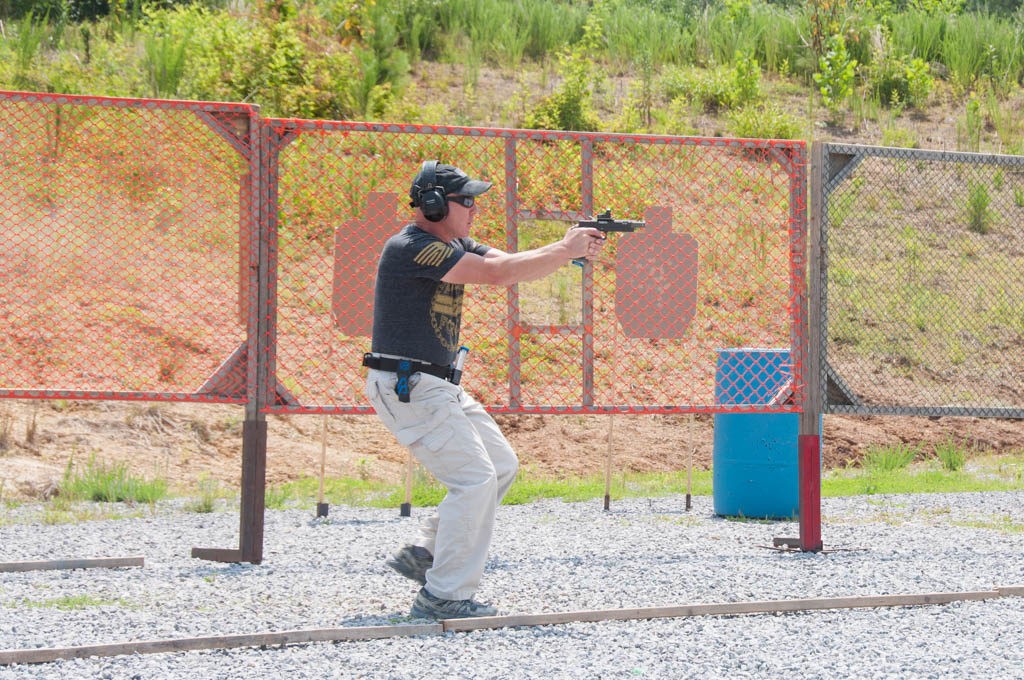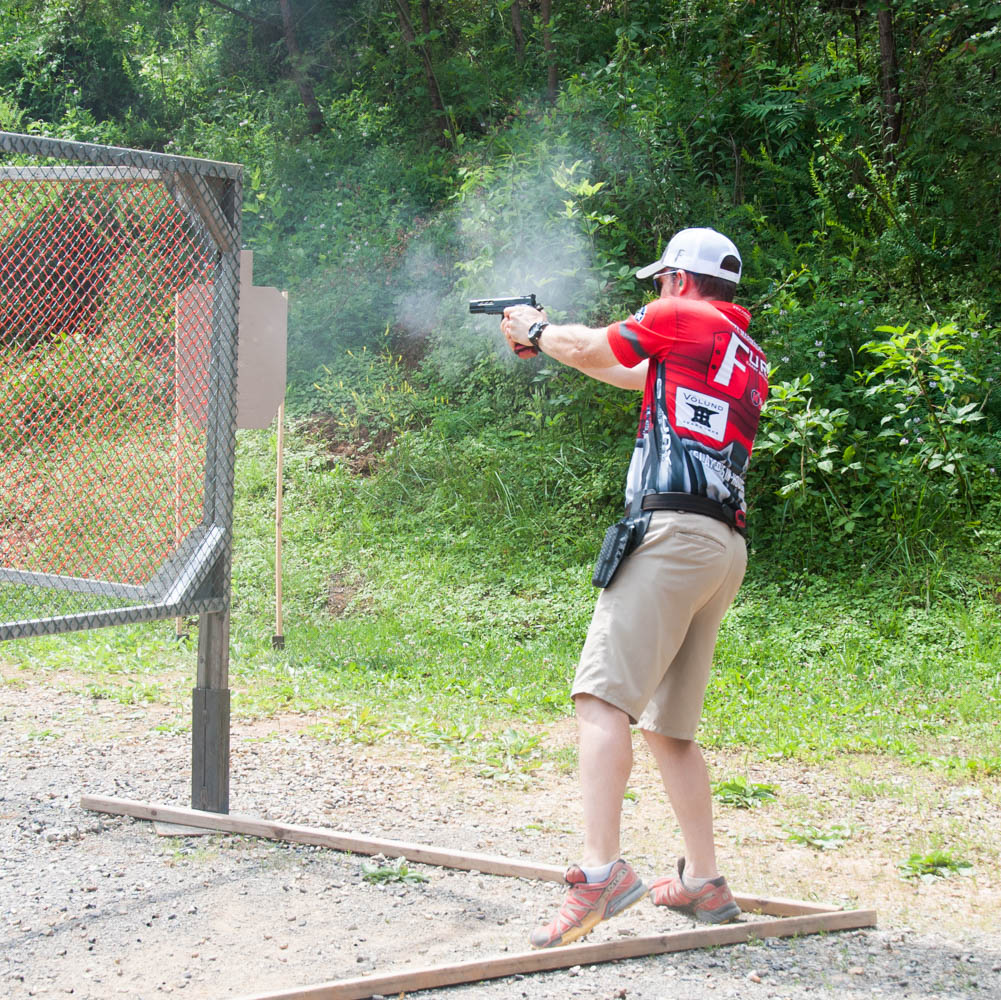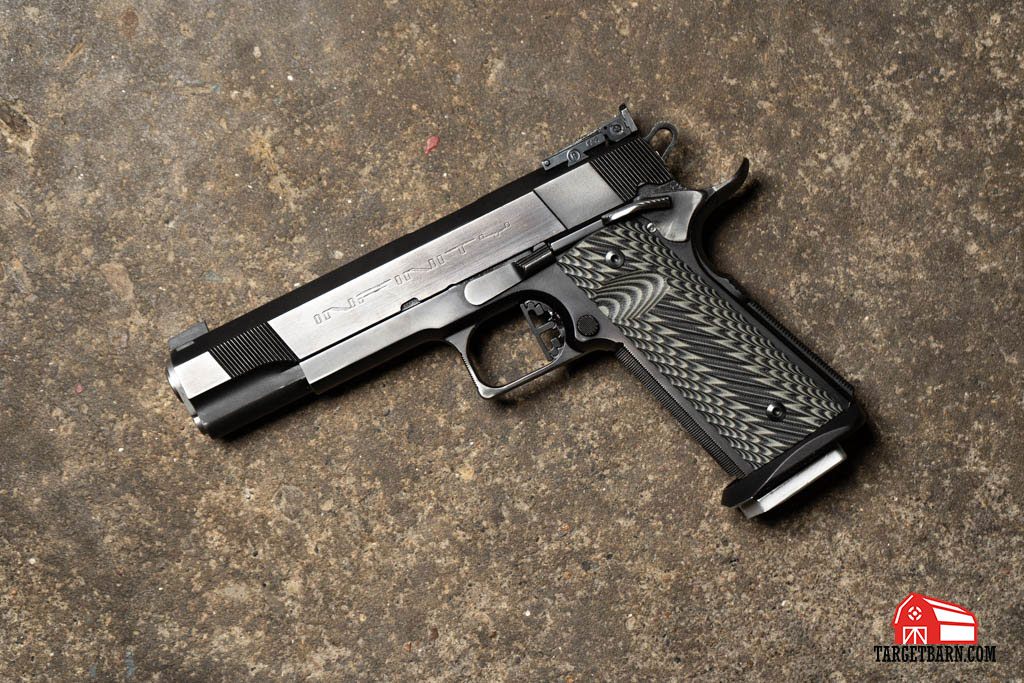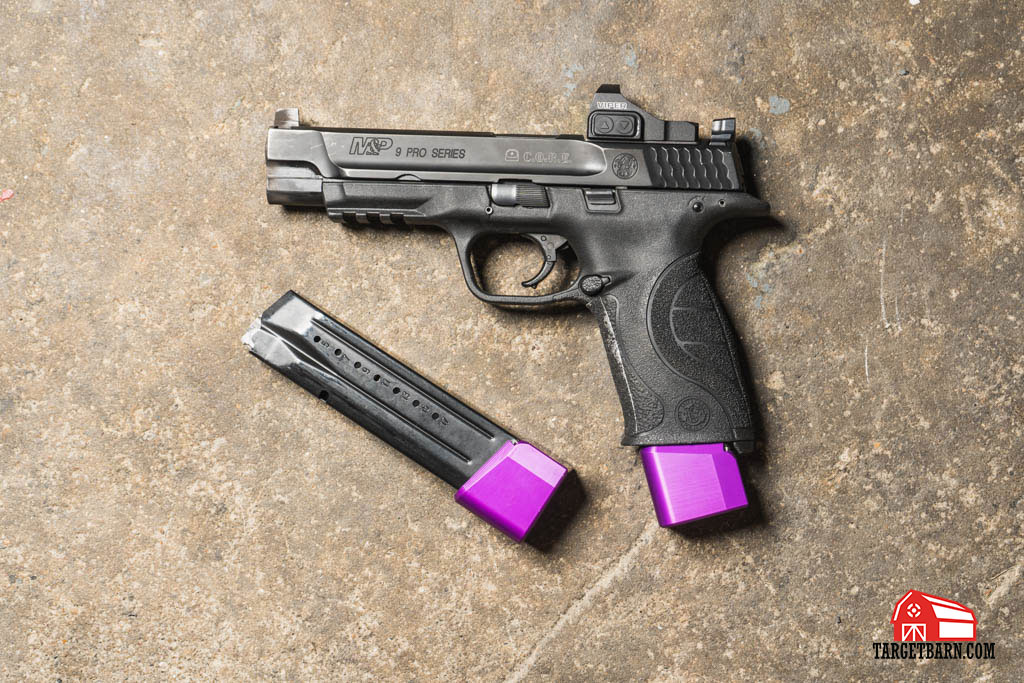The United States Practical Shooting Association represents the largest action shooting organization in the United States. With 30,000+ members and attendance at major matches frequently in the hundreds, it would create an extremely crowded landscape if all the shooters competed heads up against each other. However, just as automobile racing has different divisions and classes based on the type of car or the equipment in the car, so does USPSA.
In USPSA there are seven divisions, each defined by the type of guns and the allowed modifications to that gun. Let’s take a look at each of the USPSA divisions and see which one is a good fit!
Update: We updated this post with the 2021 USPSA Divisions rule changes and this resource is current as of June 2023.
Major vs Minor Power Factor
Before we look at the divisions, we have to understand major vs. minor Power Factor. This is a formula used in scoring, based on the “power” of the round. On C-zone and D-zone hits, major PF guns score one more point than minor PF guns. The minimum acceptable bullet diameter for all USPSA divisions is 0.355, or 9mm/38. Learn more about USPSA scoring here.
USPSA Divisions
| Division | Power Factor | Maximum Magazine Length | Maximum Ammo Capacity | Red Dot Sights Permitted | Maximum Gun Weight (w/ empty magazine inserted) | Special Conditions |
|---|---|---|---|---|---|---|
| Open | Major & Minor | 6.742" | None | Yes; frame mounted permitted | n/a | |
| Limited | Major & Minor | 5.561" or 6.742" in single stack guns | None | No | n/a | |
| Limited 10 | Major & Minor | 5.561" or 6.742" in single stack guns | 10 rounds in magazine | No | n/a | |
| Production | Minor Only | gun with inserted magazine must fit in box | 10 rounds in magazine | No | 59 ounces | Double action, double action/single action, and striker fired guns only; and gun must be on USPSA Approved Production Handgun List |
| Single Stack | Major & Minor | gun with inserted magazine must fit in box | Major PF - 8 rounds Minor PF - 10 rounds | No | 45 ounces | 1911 production type pistols only |
| Revolver | Major & Minor | n/a | Major PF - maximum 6 rounds fired before reload Minor PF - maximum 8 rounds fired before reload | No | n/a | |
| Carry Optics | Minor Only | 5.561" | None | Required; slide mounted only | 59 ounces | Double action, double action/single action, and striker fired guns only; and gun must be on USPSA Approved Production Handgun List |
| Pistol Caliber Carbine | Minor Only | n/a | None | Yes | n/a | |
| Limited Optics (Provisional) | Minor Only | 5.561" or 6.742" in single stack guns | None | Required; slide mounted only | n/a |
Open Division
| Division | Power Factor | Minimum Bullet Caliber for Major Power Factor | Maximum Magazine Length | Maximum Ammo Capacity | Red Dot Sights Permitted | Maximum Gun Weight (w/ empty magazine inserted) |
|---|---|---|---|---|---|---|
| Open | Major & Minor | No | 6.742" | None | Yes; frame mounted permitted | None |
USPSA’s oldest division is Open. It also has the most expensive and highest bar for entry, as the guns in Open feature the most modifications and add-ons in any division. Red dot sights are allowed and can be mounted to the frame, compensators to help reduce recoil are allowed, and giant magazine wells for speed reloading are just a few of the modifications you’ll see. In open division, the minimum caliber is 0.355 for bullet diameter. Shooters can use 9mm bullets that are loaded hot to make major power factor in Open.
Open is still very popular to this day. An Open gun is the ultimate expression of a race gun, like a Formula 1 or IndyCar. It has no other purpose than to go fast, and as it turns out, people still like to go fast.
Limited & Limited 10 Division
| Division | Power Factor | Minimum Bullet Caliber for Major Power Factor | Maximum Magazine Length | Maximum Ammo Capacity | Red Dot Sights Permitted | Maximum Gun Weight (w/ empty magazine inserted) |
|---|---|---|---|---|---|---|
| Limited | Major & Minor | .40 cal/10mm/.357 Sig | 5.561" or 6.742" in single stack guns | None | No | None |
| Limited 10 | Major & Minor | .40 cal/10mm/.357 Sig | 5.561" or 6.742" in single stack guns | 10 rounds in magazine | No | None |
Limited Division is the second “race” division of USPSA. The guns are extremely similar to Open guns. The major differences between Open and Limited are that in Limited, shooters must have shorter magazines, and red dot sights and compensators are not allowed. Limited allows major and minor scoring, but requires a minimum caliber of .40 SW to make major, making all 9mm guns score minor. However they do have a slight capacity advantage over the .40 S&W guns. With that being said, Limited is dominated by 2011-style double-stack guns chambered in .40.
Limited also has a sub-division called Limited-10, created to be compliant with states that ban the possession of standard capacity mags. As the name implies, a maximum of 10 rounds can be loaded into the magazine after the start signal. Limited-10 is also popular with shooters who aren’t good enough to win in Limited, so they can hide in a weaker division.
Production Division
| Division | Power Factor | Maximum Magazine Length | Maximum Ammo Capacity | Red Dot Sights Permitted | Maximum Gun Weight (w/ empty magazine inserted) | Special Conditions |
|---|---|---|---|---|---|---|
| Production | Minor Only | gun with inserted magazine must fit in box | 10 rounds in magazine | No | 59 ounces | Double action, double action/single action, and striker fired guns only; and gun must be on USPSA Approved Production Handgun List |
Production is USPSA’s most popular division, owing to the fact that it was created to give shooters a place to shoot common guns. In the 90s, if you had a Glock or a Beretta, or any of the common service pistols, you didn’t really have a division in USPSA where you could be competitive. Additionally, the Clinton-Era assault weapons ban made it difficult for some shooters to procure the necessary standard capacity magazines for Limited and Open.
Enter Production division – finally giving shooters a place to run their service and carry pistols.
For many years Production was dominated by the Glock 34, however in recent years there has been a trend towards metal framed double-action/single-action pistols, such as the Tanfoglio Stock II and the CZ-75 Shadow. This is mostly because those pistols can be tuned to have extremely light and easy to manage trigger pulls, far better than anything you can get on a Glock. Regardless, Production is the place to go if you want to shoot a “normal” gun! It has a 10 round magazine capacity limit and only scores minor, so most 9mm guns are good to go, as long as they’re on “the list.”
USPSA keeps a comprehensive list of all the guns legal for Production division.
Single Stack Division
| Division | Power Factor | Minimum Bullet Caliber for Major Power Factor | Maximum Magazine Length | Maximum Ammo Capacity | Red Dot Sights Permitted | Maximum Gun Weight (w/ empty magazine inserted) | Special Conditions |
|---|---|---|---|---|---|---|---|
| Single Stack | Major & Minor | .40 cal/10mm/.357 Sig | gun with inserted magazine must fit in box | Major PF - 8 rounds Minor PF - 10 rounds | No | 45 ounces | 1911 production type pistols only |
Single Stack division is a newish creation for USPSA. I’ll give you a hint about the guns that are legal for this division, and that hint is: “two world wars.” That’s right, this is the division exclusively for the 1911. Single Stack in USPSA allows major and minor scoring, which creates an interesting conundrum for shooters: do you shoot major and get more points but only 8 rounds in the magazine, or shoot minor and score less points but get 10 rounds in the magazine? Single Stack is really the only division where Major vs Minor scoring is actually a debate, and ultimately it depends on the shooter’s preference, shooting style, and strategy.
Revolver Division
| Division | Power Factor | Minimum Bullet Caliber for Major Power Factor | Maximum Ammo Capacity | Red Dot Sights Permitted | Maximum Gun Weight (w/ empty magazine inserted) |
|---|---|---|---|---|---|
| Revolver | Major & Minor | No minimum | Major PF - maximum 6 rounds fired before reload Minor PF - maximum 8 rounds fired before reload | No | None |
Look, I love revolver, but if we’re honest there are like 6 people who shoot it, and thanks to a rule change the only guns that are competitive in revolver are 8 shot .38s or 8 shot 9mm guns scoring minor. That’s it. If you want to shoot revolver you can. I love it, buuuuuuuut it’s just not that popular, and that’s a bummer.
Carry Optics Division
| Division | Power Factor | Maximum Magazine Length | Maximum Ammo Capacity | Red Dot Sights Permitted | Maximum Gun Weight (w/ empty magazine inserted) | Special Conditions |
|---|---|---|---|---|---|---|
| Carry Optics | Minor Only | 5.561" | None | Required; slide mounted only | 59 ounces | Double action, double action/single action, and striker fired guns only; and gun must be on USPSA Approved Production Handgun List |
What is popular is the new hotness: Carry Optics. This division was added recently to take into account the number of people who are mounting pistol red dot sights like the Trijicon RMR on the slides of their pistols. Carry Optics rules are in many ways “Open Lite” – shooters can extensively modify their pistols, and use extended magazines that hold around 20 rounds. The “race gun” type holsters seen in Open are specifically not allowed, but holsters placed in the appendix position are. It only scores minor power factor, making 9mm guns the order of the day.
Most major manufacturers offer mounting solutions for pistol optics now, so you can just buy a Glock/Sig/Beretta/Walther, toss a RMR or Deltapoint on it and be ready to go! Just no compensators or magwells, and make sure that red dot is mounted to the slide, not the frame.
Pistol Caliber Carbine Division
| Division | Power Factor | Maximum Magazine Length | Maximum Ammo Capacity | Red Dot Sights Permitted | Maximum Gun Weight (w/ empty magazine inserted) |
|---|---|---|---|---|---|
| Pistol Caliber Carbine | Minor Only | None | None | Yes | None |
Last, and least, and most ridiculous is Pistol Caliber Carbine, or PCC. This division is…well it’s people who want to shoot a 9mm rifle at a pistol match. No, I don’t get it either. It’s probably a lot of fun, and it seems to be pretty popular and catching on with a lot of people, but…it’s a rifle. At a pistol match. Good for you?
Limited Optics (Provisional) Division
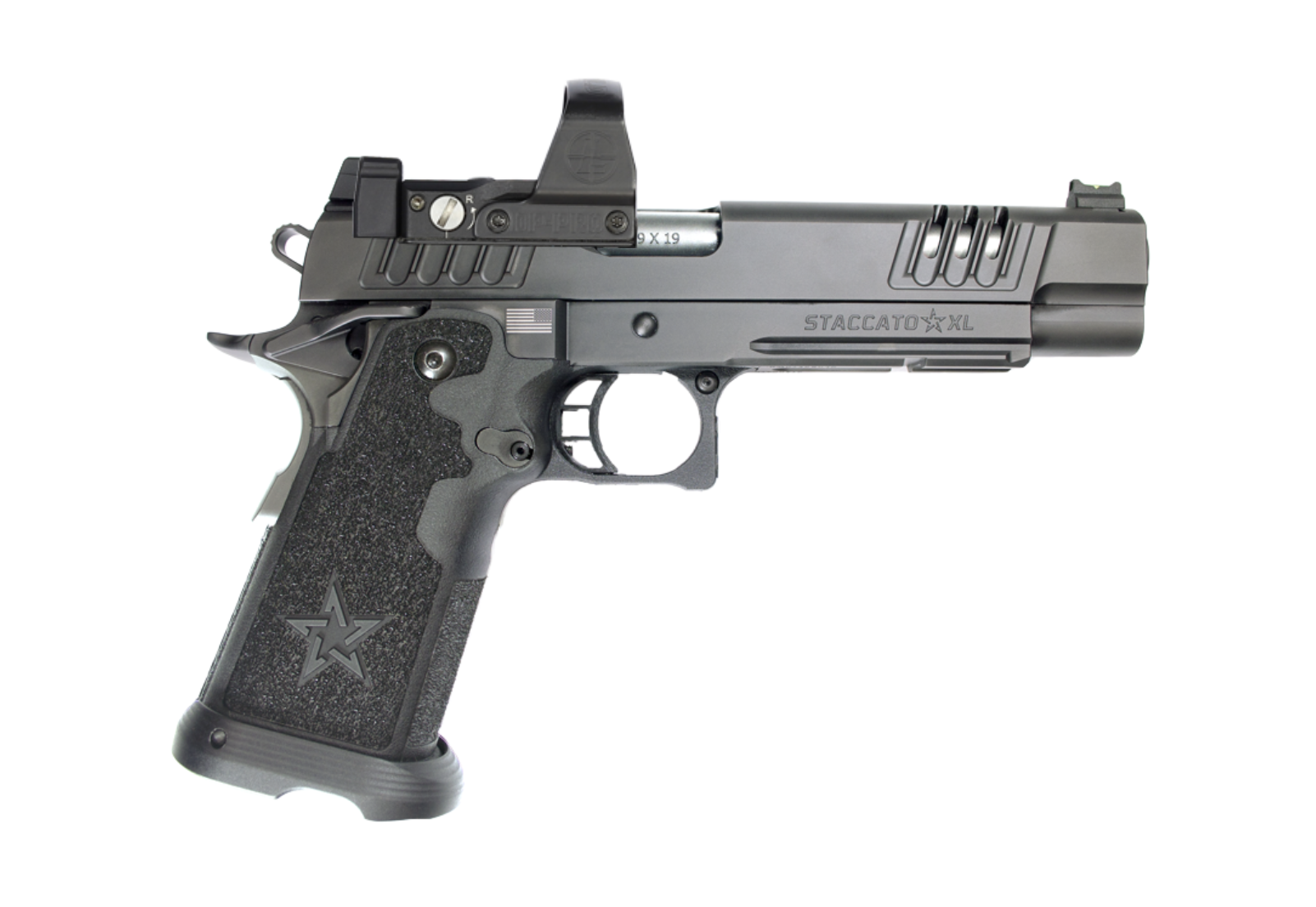
| Division | Power Factor | Maximum Magazine Length | Maximum Ammo Capacity | Red Dot Sights Permitted | Maximum Gun Weight (w/ empty magazine inserted) |
|---|---|---|---|---|---|
| Limited Optics (Provisional) | Minor Only | 5.561" or 6.742" in single stack guns | None | Required; slide mounted only | None |
Beginning on May 1, 2023, USPSA introduced a new, provisional division: Limited Optics. Limited Optics is essentially Limited division with slide-mounted optics and minor power factor scoring only.
So, what is the purpose of Limited Optics if both Open and Carry Optics already exist? Some shooters have single-action, 9mm pistols with slide-mounted red dots (like the Staccato P). They can’t shoot in Carry Optics because the gun is single-action which is prohibited in the division, and Carry Optics shooters didn’t want them added to their division anyway. They don’t want to shoot in Open because their guns are not true race guns with frame-mounted optics. Plus, Limited Optics guns are already heavily used in 2-gun and 3-gun, therefore, a new division was born – at least for a year to test the waters.
This provisional division will be available for shooters to register in for a 12-month period. During that time, USPSA will be conducting ongoing reviews and membership surveys to gather input on the division and its provisional rule-set. It’s possible that at the end of the 12-month period, USPSA will decide to eliminate the Limited Optics division. So, it’s probably not a good idea to drop a lot of money on a heavily modified pistol specifically for LO.
USPSA Divisions: Final Thoughts
That’s it! All 7 of the USPSA divisions plus one provisional division explained right here. Hopefully if you’re looking for a place to shoot, you’ll find yourself in one of these. You can find more information on where to shoot and how to find matches by visiting USPSA.org and looking for a match near you.



